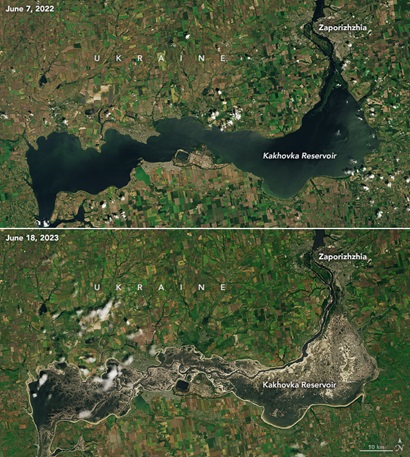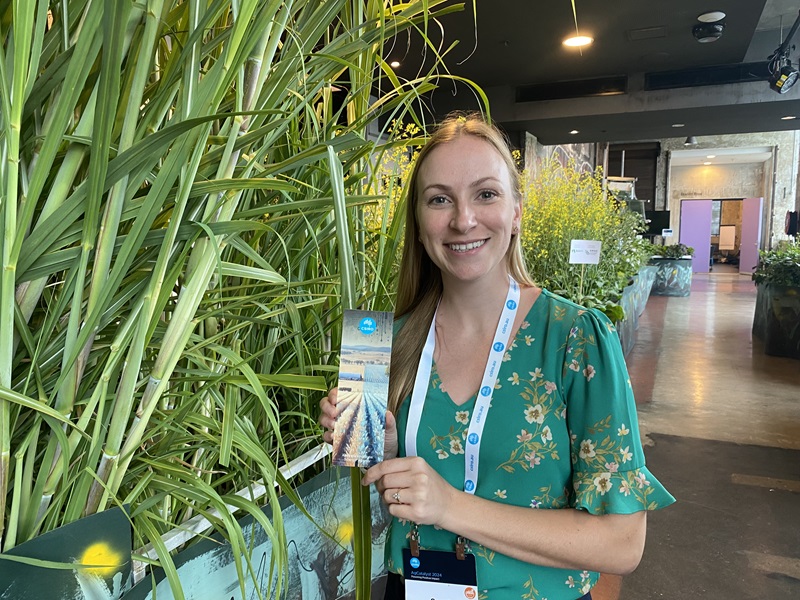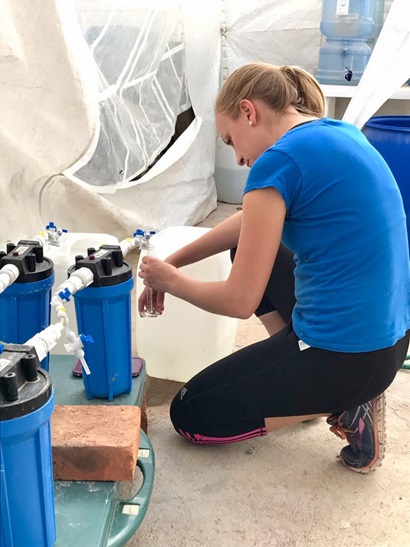Key points
- AI can uncover hidden patterns in crops and climate, offering farmers powerful new tools for resilience and productivity.
- Responsible, application-driven AI, co-designed with farmers and communities, is essential to building lasting trust in digital agriculture.
- By 2050, AI could drive resilience and sustainability - or fuel fragmentation and mistrust, depending on choices made today.
The Kakhovka Dam in Ukraine once stood 30 metres high and stretched 3.2 kilometres across the Dnieper River, creating one of the country's largest reservoirs. Holding some 18 cubic kilometres of water, it supplied irrigation across Kherson Oblast and beyond, and cooled Europe's biggest nuclear plant at Zaporizhzhia.

When the dam collapsed in June 2023, its loss unleashed catastrophic floods downstream and drained the vast reservoir upstream. Fields were left parched, canals emptied, ecosystems shattered. Toxic sediments flowed into the Black Sea, algal blooms spread, and what had been a reservoir, began transforming into a raw floodplain forest, sprouting willows and poplars over unstable ground.
Amid the upheaval, Dr Sarah Hartman, then a PhD candidate at the University of California , Berkeley, set out with her team to answer a pressing question.
"We wanted to understand how these regions were responding to disruption. Could we track agricultural resilience, even in crisis, by using AI and satellite imagery?"
With access on the ground unsafe or impossible, Sarah and her team turned to satellites and AI. Their model used publicly available Landsat imagery via Google Earth Engine and private data from Planet Labs to monitor crop health before and after the dam's destruction. Using unsupervised machine learning – a method that identifies patterns in data without pre-labelling – they detected shifts in vegetation across the region. A decision-tree model then sorted these patterns into actively managed farmland and areas showing signs of abandonment or regrowth.
The Ukraine research was undertaken as part of Sarah's PhD, with revisions to the published paper completed after she joined CSIRO as an Early Research Career (CERC) Postdoctoral Fellow . What emerged, she said, was "a mosaic of loss and persistence."
"We were able to identify zones of collapse – but also zones of recovery," she said.
This ability to see what's hidden on the ground, to interpret disruption from afar, is at the heart of AI's promise in agriculture.
What AI can reveal

Through satellite imagery, AI can highlight where irrigation systems are drying up, spot greenhouses that weren't there a decade ago, or flag fields suddenly off-course in their growth. In places where data is missing or lost, AI can reclaim knowledge, sometimes going back decades. With one caveat – Sarah stresses that AI's power is only as good as its databank.
"AI is what it eats," she said. "If we feed it sparse, outdated or biased data, we get misinformed models. But when we train models with rich, local and timely information, we grow AI that's relevant to the real and pressing needs of agriculture."
This principle is what she and colleagues call "responsible, application-driven AI" – RAD-AI for short. The approach is simple but critical: AI should be designed with and for the people who will use it, grounded in context, and fuelled by the right data.
Building trust in a sector under pressure
"It's RAD because it reminds us that responsible, application-driven AI should be grounded in context and designed for the real world," she explained.
At its heart is co-design: working alongside the people who will use the technology – agronomists, growers, agtech companies – to ensure AI reflects real needs and builds trust.
"Building context-aware capabilities responsibly from the start, with a focus on the communities that will be served, is essential," Sarah said.
Trust, she said, is also about diversity. Incorporating Indigenous knowledge systems, local data sovereignty and participatory design helps ensure AI reflects Australia's unique farming systems.
"By weaving different agricultural paradigms into development, we can build tools that are not only technically powerful but also socially equitable."
This is happening at a moment when Australia's agricultural sector is under pressure from every direction – climate change, labour shortages, productivity challenges and volatile global markets. But without targeted investment and careful design, agriculture risks missing out on the benefits of artificial intelligence (AI) at precisely the moment it is most needed.
"We have an incredible opportunity to harness AI but we need to ensure it is done responsibly and in ways that reflect the realities of Australian farming," cautioned Sarah.
As innovation gathers pace, Sarah believes responsibility cannot be an afterthought. It must be built into the process from the beginning – not only to avoid risks of bias, misuse or exclusion, but to unlock the full potential of AI as a partner in farming.

The tools already emerging
We're already seeing exciting initiatives at work in the field. On remote cattle stations, drones equipped with AI-driven algorithms are being trialled to automate mustering. Developed by the Australian company SkyKelpie , these systems predict livestock behaviour and optimise flight paths, cutting costs and environmental impacts compared with helicopters and quad bikes.
At the same time, robotics companies such as Swarmfarm are developing fully autonomous tractors that integrate multiple AI technologies. These machines hold potential to transform field operations, though technical and scaling challenges remain.
AI is also reshaping how farmers deal with the weather. Breakthroughs such as Google's GraphCast and Microsoft's Aurora are delivering forecasts with unprecedented speed and precision, supporting decision-making from planting to drought management. And generative AI is beginning to enter agriculture, from Microsoft's AgPilot chatbot to emerging platforms that can integrate farm-specific data into tailored recommendations.
Each of these advances points to AI's versatility – from livestock to logistics, forecasts to fieldwork. But they also reveal vulnerabilities. Generative AI – systems trained to create new content such as text, images or code – are prone to "hallucinations": producing confident but incorrect answers. Misapplied in agriculture, such errors could lead to costly mistakes.

Preparing for the future
Sarah's "Trusted AI Agronomist" project shows how AI can make complex crop science usable on farms. A feed-forward neural network is trained to replicate CSIRO's Agricultural Production Systems Simulator, generating crop growth forecasts under different conditions. Crucially, it also provides uncertainty bands – giving farmers not just a prediction, but a measure of confidence to guide risk-based decisions.
"Most farm decisions are made under risk, not certainty," she said. "Knowing the confidence around a prediction, and not just the average, allows farmers with different tolerances for risk to choose the action that makes the most sense."
Seeing not just a single outcome but a range of possible ones builds both trust and resilience into the decision-making process.
Meanwhile, as part of CSIRO's Ag2050 initiative, Sarah has been examining the three AI breakthroughs with the greatest potential to transform farming : data integration and analytics, weather and climate forecasting, and generative AI chatbots.
These are not abstract concepts but tangible technologies already in motion, pointing towards the kind of agricultural systems Australia could build by mid-century.
"Farming is complex, and AI can revolutionise how decisions are made," said Dr Rose Roche, CSIRO's Ag2050 lead.
"To keep farm productivity growing in the face of climate change, shifting markets and resource pressures, our Ag2050 work is showing how AI can help farmers adapt and stay resilient into the future," Rose said.
Frank Sperling co-edited Ag2050's special issue of the Farm Policy Journal , a landmark edition released by the Australian Farm Institute in collaboration with CSIRO. He said it's vital to explore diverse futures for Australian agriculture.
"With Australian agriculture having to navigate an increasingly uncertain future, where global and local risks intertwine, we need to consider multiple plausible scenarios and explore what can be done to harness opportunities, while minimising adverse outcomes," Frank said.
"This is why this work by Sarah and colleagues on responsible AI is so important," he added.
Choosing what kind of AI takes root
For Sarah, the lesson from Ukraine still resonates. Out of devastation, AI helped reveal both collapse and persistence – and now, similar technologies are being developed and trialled in Australia. From drone-assisted cattle mustering and advanced weather forecasting to generative AI tools like Microsoft's AgPilot, AI is steadily moving from research to real-world application across the agricultural sector.
The same will be true in Australia: the technologies we choose to build – and the way we choose to build them – will shape whether AI becomes a source of trust and resilience, or a cause of further risk.
It's an insight that underpins Sarah's recent recognition as winner of the Women in AI Asia-Pacificaward for AI in Agribusiness and Rural Development.
"This award is a reflection of my drive to deeply engage when making (high and low) technology solutions and ensuring they work for people," she said.
But Sarah is quick to add a note of caution: "AI is not a silver bullet. But when responsibly designed and rooted in good data, it can become a powerful tool for transforming agriculture."






